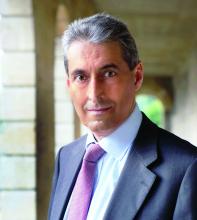SAN FRANCISCO – A postmarket analysis of the coronary intravascular lithotripsy (IVL) system validated the safety and utility of the procedure first described in the Disrupt CAD I study.
“We now have an efficient technology to treat calcium that is safe to use, simple to learn, and able to achieve 100% success in delivering stents, with low final residual stenosis (7.8%),” Carlo Di Mario, MD, said in an interview in advance of the Transcatheter Cardiovascular Therapeutics annual meeting. “This was accomplished with a low rate of complications.”
Developed by Shockwave Medical, coronary IVL is an innovative lesion preparation tool designed to fracture challenging calcium using sonic pressure waves in order to facilitate stent delivery, deployment, and optimal expansion. In a feasibility study known as DISRUPT CAD I, Dr. Di Mario, director of structural interventional cardiology at Careggi University Hospital in Florence, Italy, and his colleagues performed the procedure in 60 patients (Circulation 2019;139:834-6). Clinical success, defined as residual stenosis of less than 50% post PCI with no evidence of in-hospital major adverse cardiac events (MACE), was 95%, while device success, defined as successful delivery and IVL treatment at target lesion, reached 98.3%.
In an effort to ensure that results of DISRUPT CAD 1 were generalizable to a broader population, Dr. Di Mario and his colleagues enrolled 120 subjects at 15 sites in nine European countries into DISRUPT CAD II, a postmarket, single-arm study. They underwent vessel preparation for stent implantation with IVL, and the primary endpoint was in-hospital MACE, defined as cardiac death, myocardial infarction, or target vessel revascularization. The researchers also performed an optical coherence tomography (OCT) substudy to evaluate the mechanism of action of IVL and to quantify coronary artery calcium characteristics and calcium plaque fracture.
The mean age of the 120 patients was 72 years, 78% were male, 80% had hypertension, 72% had hyperlipidemia, 32% had diabetes, and 65% had class I or II angina. Most of the patients (94%) had severe calcification, with a mean lesion length of about 26 mm. The lesions were concentric in 70% of cases, and 30% had side-branch involvement.
Dr. Di Mario and his associates reported that IVL was delivered successfully in all cases. It also delivered stents successfully in all cases, with a high acute luminal gain (a mean of 1.7 mm2), and low residual stenosis (7.8%). The primary endpoint occurred in 5.8% of patients, consisting of seven non–Q-wave myocardial infarctions. The IVL mechanism of action was shown to be intraplaque calcium fracture, which occurred in about 80% of lesions analyzed by OCT.
“Based on my previous experience with IVL, I was confident that it could modify the calcium, but the results of the OCT substudy of the Disrupt CAD II utilizing OCT to evaluate the mechanism of action was clearly more positive than expected,” said Dr. Di Mario, who was a coprincipal investigator for the trial. “It demonstrated that IVL creates visible calcium fractures in the majority of cases and confirmed that full stent expansion secondary to the circumferential calcium modification is achievable, despite that nearly all the patients (94%) had severe coronary artery calcification. We know from previous work that full stent expansion is required to minimize complications and improve clinical outcomes, which was not always achievable before IVL.”
He acknowledged certain limitations of the study, including the fact that it lacked a concurrent control group, “but it was run very carefully with complete monitoring of events and core lab and CEC [clinical endpoint committee] adjudication,” he said. “Also, the study was used to confirm short-term safety, and as such, did not include long term follow-up.”
In an interview at the meeting, Ajay J. Kirtane, MD, an interventional cardiologist at Columbia University Medical Center, New York, called the findings “reassuring,” but said that he looks forward to results from the trial of the system currently under way in the United States known as the DISRUPT CAD III IDE Study. “The technology is accessible to many physicians because it’s a balloon-based technology,” he said. “Yet in terms of performance, we need to not only evaluate short-term outcomes, we need to see long-term outcomes as well, to make sure there are no untoward effects.”
Shockwave C2 Coronary IVL catheters are commercially available for the treatment of de novo coronary artery disease in Europe and other select countries; in the United States they are limited to investigational use within the DISRUPT CAD III IDE Study.
At the meeting, Ziad A. Ali, MD, an interventional cardiologist at Columbia University/New York–Presbyterian Hospital, presented results from Disrupt CAD II, and the content was published online at the time of presentation. The meeting was sponsored by the Cardiovascular Research Foundation. Dr. Di Mario disclosed that Shockwave Medical provided a grant for the study to Careggi University Hospital. Dr. Ali reported having personal equity and fees from Shockwave Medical, as well as grants from other companies outside the scope of the study.
SOURCE: Di Mario C et al. Circ Cardiovasc Interv. 2019 Sep 25 doi: 10.1161/CIRCINTERVENTIONS.119.008434.


